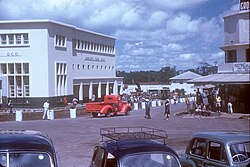The town was founded by German colonialists when the territory was part of German East Africa in 1900. A garrison town, it was named after the local tribe Wa-Arusha, who are known as Larusa by the Maasai.
The German military fortress, called a Boma[citation needed], armed with a mounted Maxim machine gun, was completed in 1901. The first commander was First Lieutenant Georg Kuster - derogatorily referred to in Swahili as "Bwana Fisi" meaning "Mr. Hyena"[citation needed]. After 1903 Arusha quickly developed into a significant trading and administrative centre, with about two dozen Indian and Arab shops clustered along what is today Boma Road.[1]
In 1904 the German Imperial authorities established a European colony here with the sponsored settlement of Boer refugee families, mostly of German descent, in the aftermath of South Africa's divisive Anglo-Boer War. The Germans arranged for the Boers to be taken by boat to Tanga, from where they travelled to Arusha by ox-wagon. When the oxen all succumbed to tsetse-borne
disease, the Germans provided the Boers with teams of (forced) local
labourers. In August 1905 they reached the Arusha district and met the
Pieter Joubert trek, which had just arrived. For their immediate sojourn
they set up camp on the farm of Mr. Nelie von Landsberg.[1]
After 1906 the government sponsored German peasants to develop
smallholdings at Leganga on southeastern Meru between Usa River and Maji
ya Chai. Several Evangelical Lutheran
settlers had already become established west of Arusha town when the
government decided to settle German refugees from southern Russia.
Forty people were recruited at a cost of 7000 marks each, and each
family was given fifty hectares to grow wheat, maize, and vegetables.[2]
In 1907 Margaret Trappe, great-grandmother of Ohio industrialist Kenyon Painter, made her home in German East Africa. An accomplished horsewoman, she was the first female professional hunter ever listed.[citation needed]
The Trappe family built their home on the slopes of Mount Meru with
their farm "Momella" eventually becoming part of Arusha National Park.
Kenyon Painter later became one of the town's most significant
investors, having invested over a million dollars in the area. He built
Arusha's first post office, church and other landmarks.[1]
In March 1916 the British occupied Arusha. The British expelled the German settlers, reallocated the German estates to British settlers, and claimed vast new tracts themselves.
In the 1960s parts of the movie Hatari! with John Wayne were filmed at Momella.
Arusha is has a been a crucial in the history of the modern Tanzania. Princess Margaret visited Arusha in 1956. Official documents ceding independence to Tanganyika were signed by the United Kingdom at Arusha in 1961. Also, the Arusha Declaration was signed in 1967 in Arusha.
The Arusha Accords were signed at Arusha on August 4, 1993, by representatives of competing factions in the Rwandan civil war.
In 1994 the UN Security Council decided by its Resolution 955 of 8 November 1994 that Arusha should host the International Criminal Tribunal for Rwanda.
The establishment of the tribunal with its employees has influenced the
local economy of Arusha. The tribunal is about to downsize due to its
closure in 2014, but its legal successor, the International Residual Mechanism for Criminal Tribunals established by United Nations Security Council Resolution 1966, will continue entertaining a branch in Arusha, opening on 1 July 2012.
Arusha officially became a city on 1 July 2006.[3]


No comments:
Post a Comment